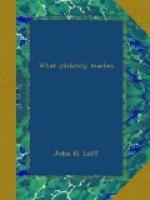Some curious varieties of this sort of printing are found among the early issues of Peru. The machine in use there printed the stamps one at a time on long strips of paper. When the end of a strip was reached another was attached to it with gum, in order that the process might be continuous. It frequently happened that an impression was printed upon or partly upon the overlapping ends of the strips. In the course of time these ends became separated and thus we find stamps embossed partly with and partly without color and occasionally entirely without it. Philatelists call these varieties semi-albinos and albinos. The latter term is also applied to envelope stamps which have been embossed without the die being inked.
Lithography, while a simpler and less expensive mode of making stamps than those previously described, is not often employed for the purpose. The work is inferior in quality and too easily counterfeited to commend itself. In lithography the lines of the design are neither sunken nor, to any appreciable extent, raised above the surface. The design is practically a drawing, in a certain greasy ink, upon stone of a particular quality. When several colors are used, as in chromo-lithography, a separate stone is prepared for each. The design is sometimes drawn directly on the stone and at others transferred to it. For stamps a die is made in wood, metal or stone. Impressions from this are made in transfer ink (a very “fat” ink, made of soap, resin, tallow, etc.) upon transfer paper. These impressions are placed, face downward, on the stone and the paper is moistened. On being passed through a press the ink adheres to the stone and the paper is easily removed. A wet sponge is passed over the stone, the water adhering to the exposed surface but not to the greasy ink. While it is moist a roller, covered with transfer ink, is rolled over the designs to which it adheres. The wetting and rolling are alternated until the designs have sufficient body. Lastly, a very weak solution of nitric acid, gum arabic and water is passed over the stone. This is at once washed off. It bites the stone to a very trifling extent and serves to clean the surface and add sharpness to the design.
Impressions taken from a lithographic stone are perfectly flat and smooth, the surface of the paper being neither raised nor depressed. They have usually a slightly greasy feel.
[Illustration, Stamp, “N. Caledonie”, 10 c.]
An interesting specimen of lithography is supplied by the first issue of New Caledonia. The design (fifty stamps in five rows of ten) was drawn upon the stone by a sergeant of Marines, named Triquera. It is said the work was done with a pointed nail. As might be expected, it was very crude.
Another interesting stamp was issued in the island of Trinidad in 1855. In this case, the stone, after the designs had been placed upon it, was very deeply bitten with acid, so that it might properly be called etched and the impressions from it be said to be typographed from stone. This stone was used in 1855, 1858 and 1860. Owing to its friable nature and want of care the stone deteriorated, so that the last impressions from it are little better than blurs.




